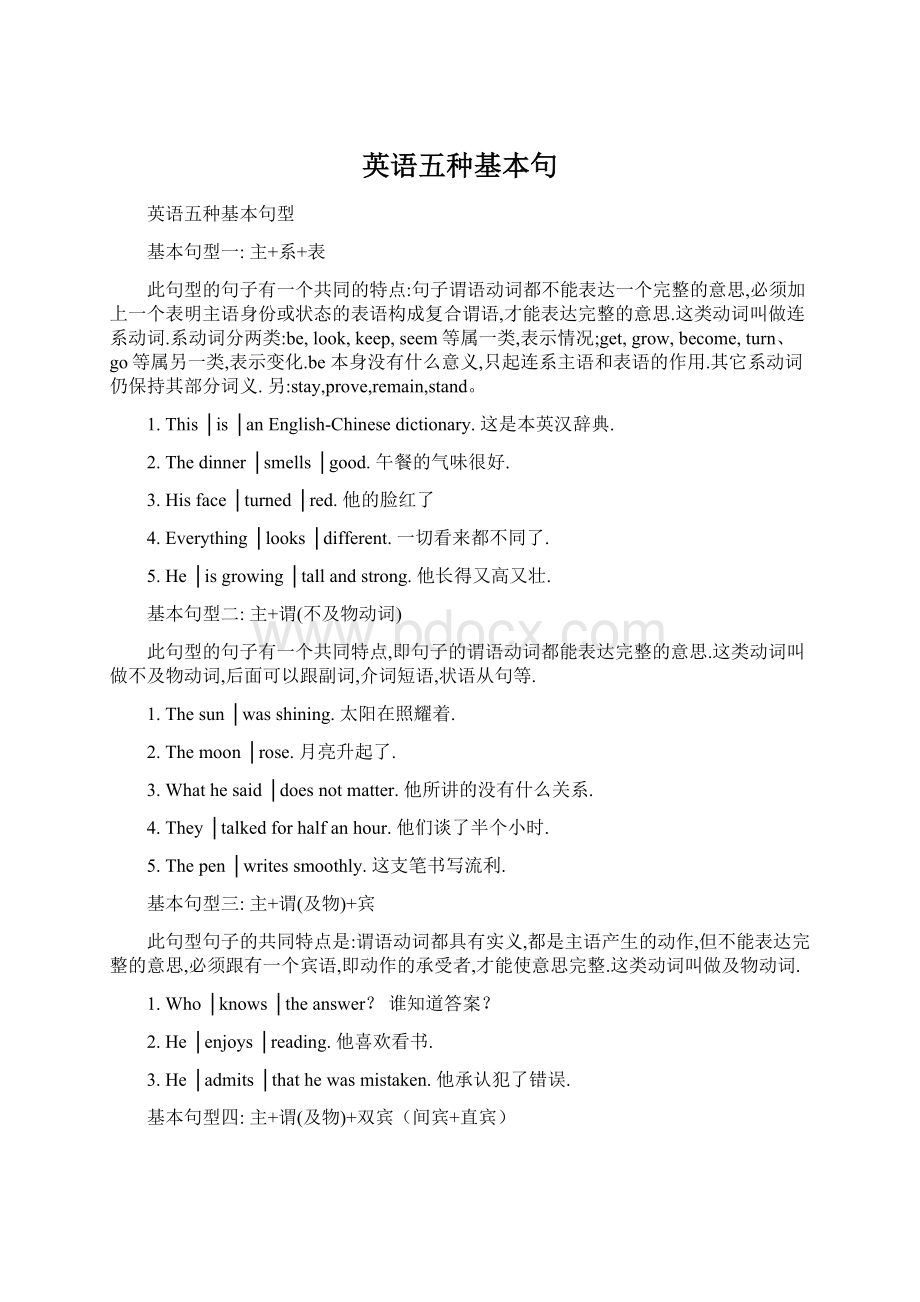英语五种基本句Word文件下载.docx
《英语五种基本句Word文件下载.docx》由会员分享,可在线阅读,更多相关《英语五种基本句Word文件下载.docx(8页珍藏版)》请在冰豆网上搜索。

此句型的句子有一个共同特点:
谓语动词必须跟有两个宾语才能表达完整的意思.这两个宾语一个是动作的直接承受者,另一个是动作的间接承受者.通常这一间接承受者用一个介词来连接,当动作的间接承受者在动作的直接承受者之前时,这一介词往往被省略.
1.She│ordered│herself│anewdress.她给自己定了一套新衣裳.
2.I│showed│him│mypictures.我给他看我的照片.
3.He│bought│you│adictionary.他给你买了一本字典.
4.I│told│him│thatthebuswaslate.我告诉他汽车晚点了.
5.He│showed│me│howtorunthemachine.他教我开机器.
基本句型五:
主+谓(及物)+复合宾语(宾+宾补)
此句型的句子的共同特点是:
动词虽然是及物动词,但是只跟一个宾语还不能表达完整的意思,必须加上一个补充成分来补足宾语,才能使意思完整.
1.They│painted│thedoor│green.他们把门漆成绿色.
2.They│found│thehouse│deserted.他们发现那房子无人居住.
3.What│makes│him│thinkso?
他怎么会这样想?
.
4.We│saw│him│out.我们送他出去.
5.He│asked│me│tocomebacksoon.他要我早点回来.
6.I│saw│them│gettingonthebusatthattime.我看见他们当时在上了那辆公共汽车.
除了基本句型的成分不变外,通常是在这些成分的前面或后面增加一些修饰语而加以扩大。
这些修饰语可以是单词(主要是形容词、副词和数词),也可以是各种类型的短语(主要是介词短语、不定式短语和分词短语)。
下面以基本句型五(v+o+o.c)为例:
Wefoundthehallfull.
我们发现礼堂坐满了。
Wefoundthegreathallfullofstudentsandteachers.
我们发现大礼堂坐满了学生和教师。
Wefoundthegreathallfullofstudentsandteachers
listeningtoanimportantreport.
我们发现大礼堂坐满了学生和教师,在听一个重要报告。
listeningtoanimportantreportmadebyacomradefromthePeople'
sDailyoncurrentaffairsinEastEurope.
我们发现大礼堂坐满了学生和教师,在听人民日报的一位同志作有关东欧局势的重要报告。
PEP小学英语重点句型语法总结与分析
三年级起点的人教版PEP教材在小学阶段共有8册书,其涉及的重要语法知识主要有7种:
tobe句型、therebe句型、一般现在时句型、现在进行时句型、一般过去时句型、情态动词can引导的句型、begoingto句型等。
现以5——8册书为例,简要分析如下:
[一]tobe句型:
用于介绍个人情况如姓名、健康状况、身份、国籍、家庭成员、朋友、职业等,描述地点、颜色、四季、日期、星期几等,该句型广泛分布于各册教材中,其中5——8册的句型主要有:
1.Who’syourEnglishteacher?
Mr.Carter.
2.What’shelike?
He’stallandstrong.
3.Isshequiet?
No,sheisn’t.
Sheisveryactive.
4.Isshestrict?
Yes,sheis,butshe’sverykind.
5.Whatdayisittoday?
It’sWednesday.
6.What’syourfavouritefruit/food…?
7.They’resweet/sour/salty/healthy/…
8.Whenisyourbirthday?
It’sinMay.
9.MybirthdayisinJune.
UncleBill’sbirthdayisinJune,too.
10.IsherbirthdayinJune?
Yes,itis.
11.What’sthedate?
12.ThisisZhangPeng.
13.Whereisthecinema,please?
It’snexttothehospital.
14.Howtallareyou?
I’m164cmtall.
15.Youareshorterthanme.
16.You’re4cmtallerthanme.
17.Howheavyareyou?
I’m48kg.
18.I’mthinnerthanyou,andshorter.
19.What’sthematterwithyou?
Mythroatissore.
20.Howareyou,LiuYun/Sarah?
[二]therebe句型:
表示存在,即:
“某处有某物”或“某时有某事”。
句型基本结构为:
Thereis+可数名词单数或不可数名词+时间或地点。
Thereare+可数名词复数+地点。
该句型主要分布在第5册的Unit5和Unit6中,如:
1.Therearetwobedrooms,akitchen,abathroomandalivingroom.
2.Thereisamirror,abedandabigcloset.
3.Isthereaforestinthepark?
Yes,thereis.
4.Isthereariver?
No,thereisn’t.
5.Arethereanypandasinthemountains?
No,therearen’t.
6.Arethereanyfishintherivers?
Yes,thereare.
[三]一般现在时句型:
表示习惯性的动作或行为,或现在存在着的状况。
主语+行为动词+其他。
当主语是第三人称单数时,要在动词原形后面加s或es,其他人称作主语时则用动词原形,在问句及否定句中需要用助动词do或does。
这种句型通常有一些标志词,如:
usually
often
sometimes
never
always等。
该句型主要分布在第5册Unit2&
3,第6册Unit1&
2,第7册Unit4,5,6,第8册Unit2中。
如:
Book5:
1.WhatdoyouhaveonThursdays?
WehaveEnglish,mathandscienceonThursdays.
2.WhatdoyoudoonSaturdays?
IwatchTVonSaturdays.
3.Idomyhomework.
4.WhatdoyouhaveforlunchonMondays?
Wehavetomatoes,tofuandfish.
5.Ilikefruit.ButIdon’tlikegrapes.
Book6:
1.Whendoyoueatdinner?
Ieatdinnerat7:
00intheevening.
2.Whendoyougetup?
Iusuallygetupat12:
00noon.
3.Whatdoyoudoontheweekend?
UsuallyIwatchTVandgoshopping.
4.SometimesIvisitmygrandparents.Ioftenplayfootball.SometimesIgohiking.
5.Whichseasondoyoulikebest?
Ilikewinterbest.
6.Whydoyoulikesummer/winter?
Book7:
1.Howdoyougotoschool,Sarah?
2.UsuallyIgotoschoolonfoot.
SometimesIgobybike.
3.Ilikecollectingstamps.Helikescollectingstamps,too.
4.Doessheteachmath?
Yes,shedoes.
5.DoessheteachEnglish?
No,shedoesn’t.
Sheteachesmath.
6.Whatdoesyourmotherdo?
Whatdoesyourfatherdo?
7.Wheredoesshework?
Sheworksinacarcompany.
8.Howdoesshegotowork?
Shegoestoworkbybus.
9.Wheredoestheraincomefrom?
Itcomesfromtheclouds.
10.Wheredoesthecloudcomefrom?
Itcomesfromthevapour.
11.Wheredoesthevapourcomefrom?
Itcomesfromthewaterintheriver.
12.Thesunshinesandthewaterbecomesvapour.
13.Howdoyoudothat?
Book8:
1.Mynosehurts.
2.Howdoyoufeel?
Ifeelsick.
HowdoesAmyfeel?
3.Youlooksohappy.
Youlooksadtoday.
[四]现在进行时句型:
表示说话时正在进行的动作或事件,或在短期内正在进行的动作或存在的情况。
标志词是:
now也常用在Look!
Listen!
等后面。
句型主要结构为:
be动词(am,is,are)+动词现在分词(v.ing)。
该句型主要分布在第6册Unit4,5,6中。
1.Whatareyoudoing?
I’mdoingthedishes.
I’mreadingabook.
2.Grandpaiswritingaletter.
Brotherisdoinghomework.Momiscookingdinnerinthekitchen.
3.Heiswritingane-mailinthestudy.
3.Whatisitdoing?
It’seatingbananas.
4.Whatisshedoing?
She’sjumping.
5.Whataretheydoing?
They’reswimming.
They’reclimbingtrees.
6.Areyoueatinglunch?
No,wearen’t.
7.Aretheyeatingthehoney?
Yes,theyare.
8.Isheplayingchess?
Yes,heis.
9.Isshecountinginsects?
No,sheisn’t.
[五]一般过去时句型:
表示过去发生的而现在已经结束的事件、动作或情况。
主语+动词过去式+其他。
标志词通常是:
yesterday,lastweek,
lastyear等,在问句与否定句中要用助动词did。
该句型分布在第8册Unit3&
4中。
1.Whatdidyoudolastweekend?
Iplayedfootball.
2.Didyouhelpthemcleantheirroom?
Yes,Idid.
3.Whatdidyoudoyesterday?
Iwentfishing.
4.Didyoureadbook?
5.Didyoucleanyourroom?
No,Ididn’t.
6.Wheredidyougoonyourholiday?
IwenttoXinjiang.
7.Whatdidyoudothere?
Isanganddancedwithmynewfriends.
8.Howdidyougothere?
Iwentbytrain.
此外,一般过去时也可用来表示客气的询问。
Book3Unit5,Book5Unit3中的:
Whatwouldyoulikeforlunch?
I’dlikesome…
[六]情态动词can引导的句型:
表示有能力做某事,can后面的动词要用原形。
该句型主要分布在第5册Unit4和第7册Unit1中。
1.Whatcanyoudo?
Icansweepthefloor.
Icancookthemeals.
2.Icanwatertheflowers.
3.Canyoumakethebed?
No,Ican’t.
4.Canyouuseacomputer?
Yes,Ican.
:
HowcanIgettoZhongshanPark?
YoucangobytheNo.15bus.
[七]将来时:
我们的教材中出现过两种表示将来时的句型,即:
will和begoingto句型,主要以begoingto句型为主,表示将要做某事或打算做某事。
句型主要结构:
am/is/are+goingto+v.原形。
标志词有:
tomorrow
nextweekend
thismorning
thisweekend
next…begoingto
1.Whatareyougoingtodothisweekend?
Iamgoingtovisitmygrandparents.
2.Whereareyougoing?
Iamgoingtothecinema.
3.HowishegoingtoBeijing?
HeisgoingtoBeijingbyplane.
4.WhenisshegoingtoXiashan?
Sheisgoingtogothereat9:
00am
一般过去时
一般现在时
现在进行时
一般将来时
定义
表示过去某个时间发生的动作或存在的状态
表示现在经常反复发生的动作、存在的状态或习惯性的动作的时态。
表示说话时或说话前后正在发生的动作或事情
表示将来某一时刻的动作或状态,或将来某一段时间内经常的动作或状态。
肯定句
主语+动词的过去式+yesterday
主语+often+动词、主语(第三人称)+often+动词(单三)
主语+be+动词的现在分词+now
主语+will+动词原形+tomorrow
否定句
主语+didnot+动词原形+yesterday
主语+donot+动词原形
主语(第三人称)+doesnot动词原形
主语+be
+not+动词的现在分词+now
主语+will+not+动词原形+tomorrow
疑问句
Did+主语+动词原形+其它
Do+主语++动词原形
Does+主语(第三人称)+动词原形
Be+主语+动词的现在分词+now
Will+主语+动词原形+tomorrow
特殊疑问句
疑问词+Did+主语+动词原形+其它
疑问词+do+主语++动词原形
疑问词+does+主语+动词原形
疑问词+de+主语+动词的现在分词
疑问词+will+主语+动词原形+tomorrow
时间状语
last
year,
yesterday
OnSunday.everyday
now
tomorrow.nextweek、fromnowon;
inthefuture
构成规则
①一般在动词原形末尾直接加上-ed。
②以不发音的字母e结尾的动词,去e再加-ed。
③末尾只有一个辅音字母的重读闭音节,先双写这个辅音字母,再加-ed。
④末尾是辅音字母+y结尾的动词,先变y为i,然后再加-ed。
一般情况1.在词尾直接加-s:
reads,writes
2.以ch,sh,s,x,o结尾的词词尾加-es:
Teaches,washes,guesses,,goes3.以辅音字母+y结尾的词变y为i,再加-es:
carries
①一般在动词原形末尾直接加上-ing。
②以不发音的字母e结尾的动词,去e再加-ing。
③末尾只有一个辅音字母的重读闭音节,先双写这个辅音字母,再加-ing。